Abstract
Introduction:
The aim of this paper is to discuss the mechanical and geometric features of Nickel-titanium (NiTi) rotary files and its clinical effects. NiTi rotary files have been introduced to the markets with their own geometries and claims that they have better ability for the root canal shaping than their competitors. The contents of this paper include the (possible) interrelationship between the geometries of NiTi file (eg. tip, taper, helical angle, etc) and clinical performance of the files as follows;
Go to : 
References
1. Schilder H. Cleaning and shaping the root canal. Dent Clin North Am. 1974; 18:269–296.
3. Ruddle CJ. Cleaning and shaping root canal systems. Cohen S, Burns RC eds., editorsPathways of the pulp. 8th ed.St Louis: CV Mosby;2002. p. 231–291.
4. Roane JB, Sabala CL, Duncanson MG Jr. The “balanced force”concept for instrumentation of curved canals. J Endod. 1985; 11:203–211.
5. Peters OA. Current Challenges and Concepts in the Preparation of Root Canal Systems: A Review. J Endod. 2004; 30:559–567.

6. Chen JL, Messer HH. A comparison of stainless steel hand and rotary nickel-titanium instrumentation using a silicone impression technique. Aust Dent J. 2002; 47:12–20.

7. Jafarzadeh H, Abbott PV. Ledge Formation: Review of a Great Challenge in Endodontics. J Endod. 2007; 33:1155–1162.

8. Peters OA, Scho ¨nenberger K, Laib A. Effects of four Ni-Ti preparation techniques on root canal geometry assessed by micro computed tomography. Int Endod J. 2001; 34:221–230.

9. Walia HM, Brantley WA, Gerstein H. An initial investigation of the bending and torsional properties of Nitinol root canal files. J Endod. 1988; 14:346–351.

10. Scha ¨fer E, Schulz-Bongert U, Tulus G. Comparison of hand stainless steel and nickel titanium rotary instrumentation: a clinical study. J Endod. 2004; 30:432–435.
11. Garip Y, Gunday M. The use of computed tomography when comparing nickeltitanium and stainless steel files during preparation of simulated curved canals. Int Endod J. 2001; 34:452–457.

12. Scha ¨fer E. Shaping ability of Hero 642 rotary nickel-titanium instruments and stainless steel hand K-Flexofiles in simulated curved root canals. Oral Surg Oral Med Oral Pathol Oral Radiol Endod. 2001; 92:215–220.
13. Cheung GSP, Liu CSY. A retrospective study of endodontic treatment outcome between nickel-titanium rotary and stainless steel hand filing techniques. J Endod. 2009; 35:938–943.

14. Seltzer S, Naidorf IJ. Flare-ups in endodontics: I. Etiological factors. J Endod. 1985; 11:472–478.

15. Plotino G, Grande NM, Cordaro M, Testarelli L, Gambarini G. A Review of Cyclic Fatigue Testing of Nickel-Titanium Rotary Instruments. J Endod. 2009; 35:1469–1476.

16. Pruett JP, Clement DJ, Carnes DL Jr. Cyclic fatigue testing of nickel-titanium endodontic instruments. J Endod. 1997; 23:77–85.

17. Sattapan B, Nervo GJ, Palamara JE, Messer HH. Defects in rotary nickel-titanium files after clinical use. J Endod. 2000; 26:161–165.

18. Shen Y, Cheung GS, Bian Z, Peng B. Comparison of defects in ProFile and ProTaper systems after clinical use. J Endod. 2006; 32:61–65.

19. Gambarini G, Grande NM, Plotino G, Somma F, Garala M, De Luca M, Testarelli L. Fatigue resistance of engine-driven rotary nickel-titanium instruments produced by new manufacturing methods. J Endod. 2008; 34:1003–1005.

20. Best S, Watson P, Pilliar R, Kulkarni GG, Yared G. Torsional fatigue and endurance limit of a size 30 .06 ProFile rotary instrument. Int Endod J. 2004; 37:370–373.

21. Peters OA, Peters CI, Scho ¨nenberger K, Barbakow F. ProTaper rotary root canal preparation: assessment of torque and force in relation to canal anatomy. Int Endod J. 2003; 36:93–99.

22. Kramkowski TR, Bahcall J. An In Vitro Comparison of Torsional Stress and Cyclic Fatigue Resistance of ProFile GT and ProFile GT Series X Rotary Nickel-Titanium Files. J Endod. 2009; 35:404–407.

25. Yared GM, Bou Dagher FE, Machtou P. Influence of rotational speed, torque and operator's proficiency on ProFile failures. Int Endod J. 2001; 34:47–53.

26. Schrader C, Peters OA. Analysis of Torque and Force with Differently Tapered Rotary Endodontic Instruments In Vitro. J Endod. 2005; 31:120–123.

27. Uroz-Torres D, Gonza′lez-Rodrl′guez MP, Ferrer-Luque CM. Effectiveness of a Manual Glide Path on the Preparation of Curved Root Canals by Using Mtwo Rotary Instruments. J Endod. 2009; 35:699–702.

28. Patiño PV, Biedma BM, Lie′bana CR, Cantatore G, Bahillo JG. The influence of a manual glide path on the separation rate of NiTi rotary instruments. J Endod. 2005; 31:114–116.
29. Berutti E, Cantatore G, Castellucci A, Chiandussi G, Pera F, Migliaretti G, Pasqualini D. Use of nickel-titanium rotary PathFile to create the glide path: comparison with manual preflaring in simulated root canals. J Endod. 2009; 35:408–412.

30. Buchanan LS. The standardized-taper root canal preparation - Part 3. GT file technique in Large Root canals with small apical diameters. Int Endod J. 2001; 34:149–156.

31. Schrader C, Ackermann M, Barbakow F. Step-by-step description of a rotary root canal preparation technique. Int Endod J. 1999; 32:312–320.

32. Rui He, Jun Ni. Design Improvement and Failure Reduction of Endodontic Files through Finite Element Analysis: Application to V-Taper File Designs. J Endod. 2010; 36:1552–1557.
33. Kim TO, Cheung GS, Lee JM, Kim BM, Hur B, Kim HC. Stress distribution of three NiTi rotary files under bending and torsional conditions using a mathematic analysis. Int Endod J. 2009; 42:14–21.

34. Kim HC, Kim HJ, Lee CJ, Kim BM, Park JK, Versluis A. Mechanical response of nickel-titanium instruments with different cross-sectional designs during shaping of simulated curved canals. Int Endod J. 2009; 42:593–602.

35. Xu X, Eng M, Zheng Y, Eng D. Comparative study of torsional and bending properties for six models of nickel-titanium root canal instruments with different cross-sections. J Endod. 2006; 32:372–375.

36. Berutti E, Chiandussi G, Gaviglio I, Ibba A. Comparative analysis of torsional and bending stresses in two mathematical models of nickel-titanium rotary instruments: ProTaper versus ProFile. J Endod. 2003; 29:15–19.

37. Kim HC, Cheung GS, Lee CJ, Kim BM, Park JK, Kang SI. Comparison of forces generated during root canal shaping and residual stresses of three nickel-titanium rotary files by using a three-dimensional finite-element analysis. J Endod. 2008; 34:743–747.

38. Walsch H. The hybrid concept of nickel-titanium rotary instrumentation. Dent Clin North Am. 2004; 48:183–202.

39. Setzer FC, Kwon TK, Karabucak B. Comparison of Apical Transportation between Two Rotary File Systems and Two Hybrid Rotary Instrumentation Sequences. J Endod. 2010; 36:1226–1229.

40. Ca∧mara AS, de Castro Martins R, Viana AC, de Toledo Leonardo R, Buono VT, de Azevedo Bahia MG. Flexibility and Torsional Strength of ProTaper and ProTaper Universal Rotary Instruments Assessed by Mechanical Tests. J Endod. 2009; 35:113–116.
41. Kim JW, Park JK, Hur B, Kim HC. Comparison of shaping ability using various Nickel-Titanium rotary files and hybrid technique. J Kor Acad Cons Dent. 2007; 32:530–541.

42. Hong ES, Park JK, Hur B, Kim HC. Comparison of shaping ability between various hybrid instrumentation methods with ProTaper. J Kor Acad Cons Dent. 2006; 31:11–19.

43. Park SY, Cheung GS, Yum J, Hur B, Park JK, Kim HC. Dynamic torsional resistance of nickel-titanium rotary instruments. J Endod. 2010; 36:1200–1204.

44. Kim HC, Yum J, Hur B, Cheung GS. Cyclic fatigue and fracture characteristics of ground and twisted nickel-titanium rotary files. J Endod. 2010; 36:147–152.

45. Larsen CM, Watanabe I, Glickman GN, He J. Cyclic fatigue analysis of a new generation of nickel titanium rotary instruments. J Endod. 2009; 35:401–403.

46. Yum J, Cheung GS, Park JK, Hur B, Kim HC. Torsional Strength and Toughness of Nickel-Titanium Rotary Files. J Endod. 2011; in press (doi:10.1016/j.joen.2010.11.028).

47. Wolcott J, Himel V. Torsional properties of nickel-titanium versus stainless steel endodontic files. J Endod. 1997; 23:217–220.

48. Kuhn G, Jordan L. Fatigue and Mechanical Properties of Nickel-Titanium Endodontic Instruments. J Endod. 2002; 28:716–720.

49. Bahia MG, Melo MC, Buono VT. Influence of simulated clinical use on the torsional behavior of nickel-titanium rotary endodontic instruments. Oral Surg Oral Med Oral Pathol Oral Radiol Endod. 2006; 101:675–680.

50. Gere JM. Mechanics of materials. 5th ed.Pacific Grove, California: Brooks-Cole;2001. Chapter 1. p. p1–66.

51. Johnson E, Lloyd A, Kuttler S, Namerow K. Comparison between a novel nickel-titanium alloy and 508 nitinol on the cyclic fatigue life of ProFile 25/.04 rotary instruments. J Endod. 2008; 34:1406–1409.

52. Al-Hadlaq SM, Aljarbou FA, AlThumairy RI. Evaluation of cyclic flexural fatigue of M-wire nickel-titanium rotary instruments. J Endod. 2010; 36:305–307.

53. Kramkowski TR, Bahcall J. An in vitro comparison of torsional stress and cyclic fatigue resistance of ProFile GT and ProFile GT Series X rotary nickel-titanium files. J Endod. 2009; 35:404–407.

54. da Cunha Peixoto IF, Pereira ES, da Silva JG, Viana AC, Buono VT, Bahia MG. Flexural fatigue and torsional resistance of ProFile GT and ProFile GT series X instruments. J Endod. 2010; 36:741–744.

55. Anderson ME, Price JW, Parashos P. Fracture resistance of electropolished rotary nickel-titanium endodontic instruments. J Endod. 2007; 33:1212–1216.

56. Bui TB, Mitchell JC, Baumgartner JC. Effect of elec-tropolishing ProFile nickel-titanium rotary instruments on cyclic fatigue resistance, torsional resistance, and cutting efficiency. J Endod. 2008; 34:190–193.

57. Adorno CG, Yoshioka T, Suda H. The effect of root preparation technique and instrumentation length on the development of apical root cracks. J Endod. 2009; 35:389–392.

58. Cheng R, Zhou XD, Liu Z, Yang H, Gao QH, Hu T. Finite element analysis of the effects of three preparation techniques on stresses within roots having curved canals. Int Endod J. 2009; 42:220–226.

59. Bier CA, Shemesh H, Tanomaru-Filho M, Wesselink PR, Wu MK. The ability of different nickel-titanium rotary instruments to induce dentinal damage during canal preparation. J Endod. 2009; 35:236–238.

60. Kim HC, Lee MH, Yum J, Versluis A, Lee CJ, Kim BM. Potential relationship between design of nickel-titanium rotary instruments and vertical root fracture. J Endod. 2010; 36:1195–1199.

61. Oh SH, Park JK, Hur B, Kim HC. Comparison of screw-in effect of three NiTi file systems used by undergraduates. J Kor Acad Cons Dent. 2006; 31:477–484.

62. Son JY, Ha JH, Kim YK. Influence of root canal curvature on the screw-in effect of nickel-titanium rotary files in simulated resin root canal. J Kor Acad Cons Dent. 2010; 35:374–379.

63. Sung HJ, Ha JH, Kim SK. Influence of taper on the screw-in effect of nickel-titanium rotary files in simulated resin root canal. J Kor Acad Cons Dent. 2010; 35:380–386.

64. Lertchirakarn V, Palamara JE, Messer HH. Patterns of vertical root fracture: factors affecting stress distribution in the root canal. J Endod. 2003; 29:523–528.

65. Tamse A, Fuss Z, Lustig J, Kaplavi J. An evaluation of endodontically treated vertically fractured teeth. J Endod. 1999; 25:506–508.

66. Peters OA, Boessler C, Paque′ F. Root canal preparation with a novel nickel-titanium instrument evaluated with micro-computed tomography: canal surface preparation over time. J Endod. 2010; 36:1068–1072.

67. Yared G. Canal preparation using only one Ni-Ti rotary instrument: preliminary observations. Int Endod J. 2008; 41:339–344.

68. De-Deus G, Barino B, Zamolyi RQ, Souza E, Fonseca A Jr, Fidel S, Fidel RA. Suboptimal debridement quality produced by the single-file F2 ProTaper technique in oval-shaped canals. J Endod. 2010; 36:1897–1900.

Go to : 
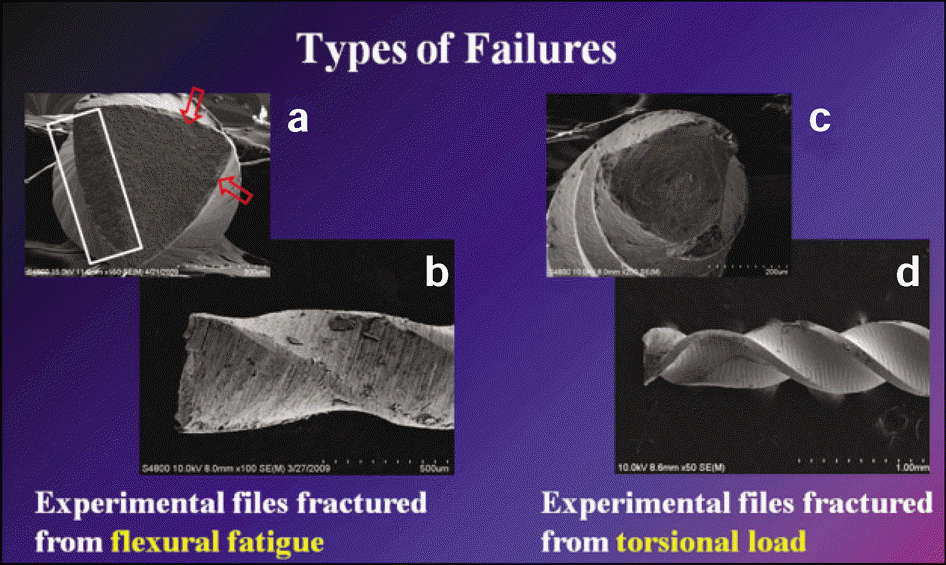 | Figure 1.Fracture modes of Nickel-Titanium rotary files. (a, b) Experimental files fractured from flexural fatigue. Figure (a) shows crack initiation zone (arrow) and fast fracture zone (box) which are common findings in cyclic fatigue fracture. (c, d) Experimental files fractured from torsional load. Figure (c) shows circular abrasion marks and skewed dimples at the center of rotation which are common findings in torsional fracture. |
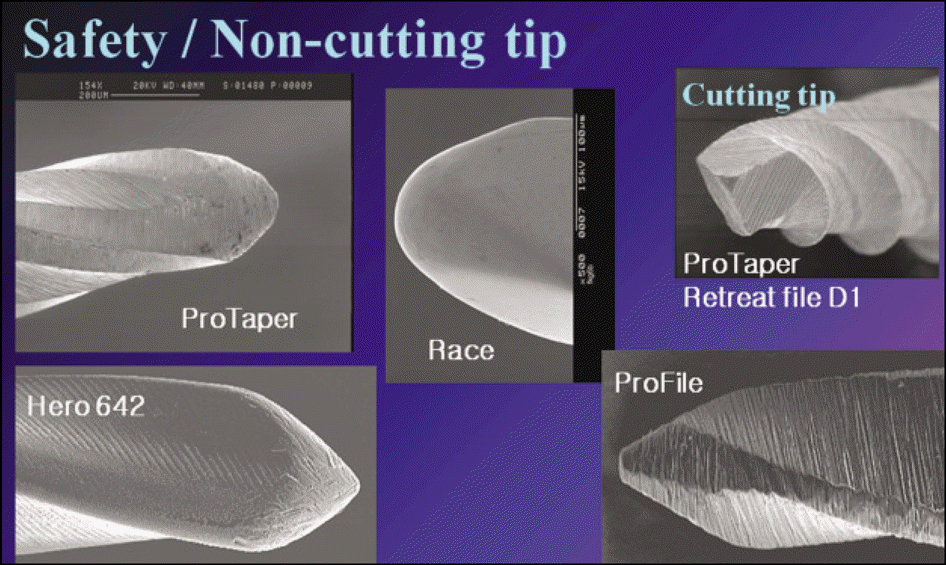 | Figure 2.Non-cutting guiding tip of Nickel-Titanium rotary files. ProTaper retreatment file D1 has cutting tip. |
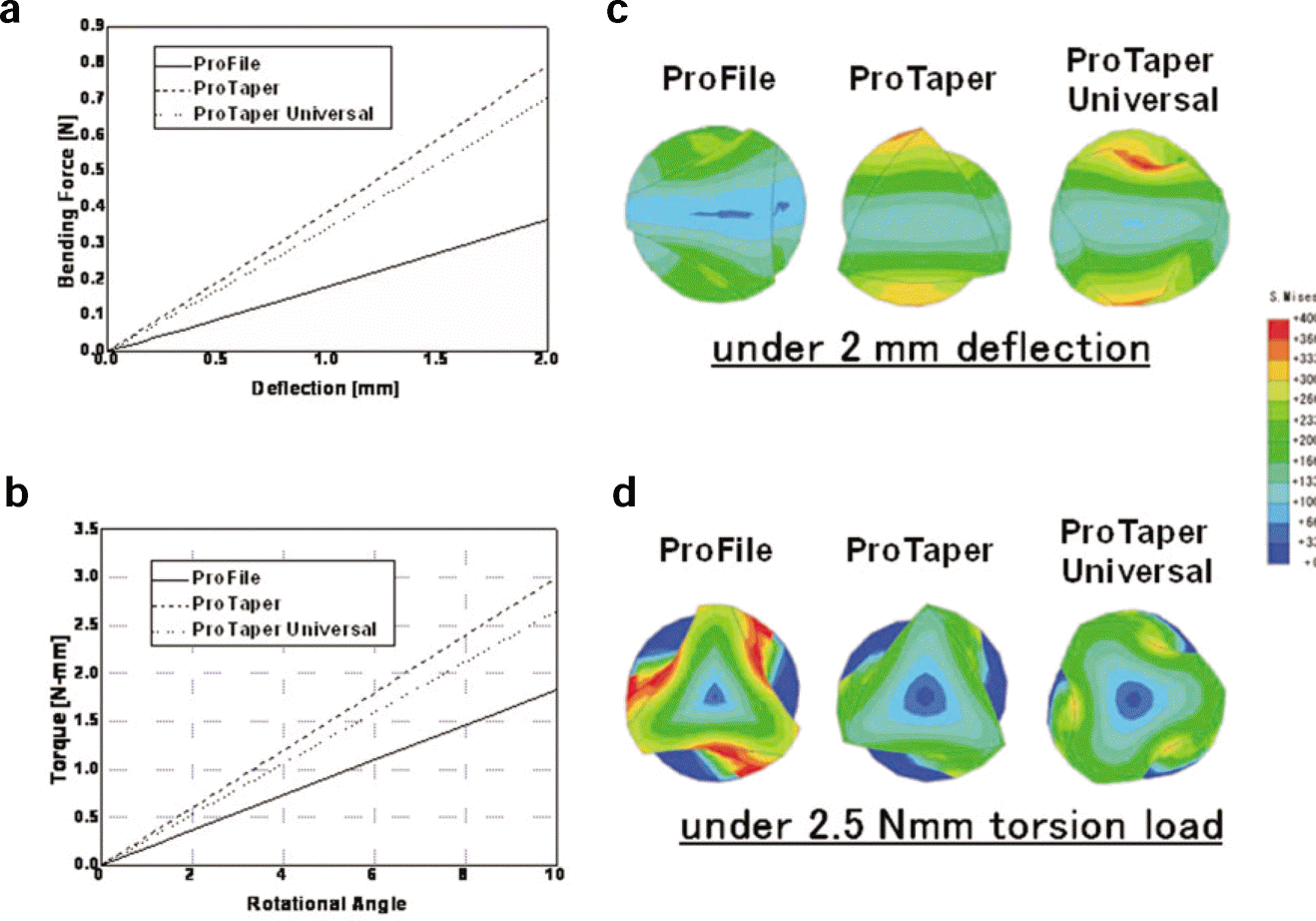 | Figure 3.Mechanical responses on bending force and torque for ProFile .06/30, ProTaper F3 and ProTaper Universal F3. (a) Bending moment needed to deflect the tip. (b) Torque required to rotate the file under 4 mm tip restriction. (c) von Mises stresses distribution under 2 mm deflection. (d) von Mises stresses distribution under 2.5 Nmm torsion load. This figure is reproduced from the International Endodontic Journal 2009;42:14-21.33
|
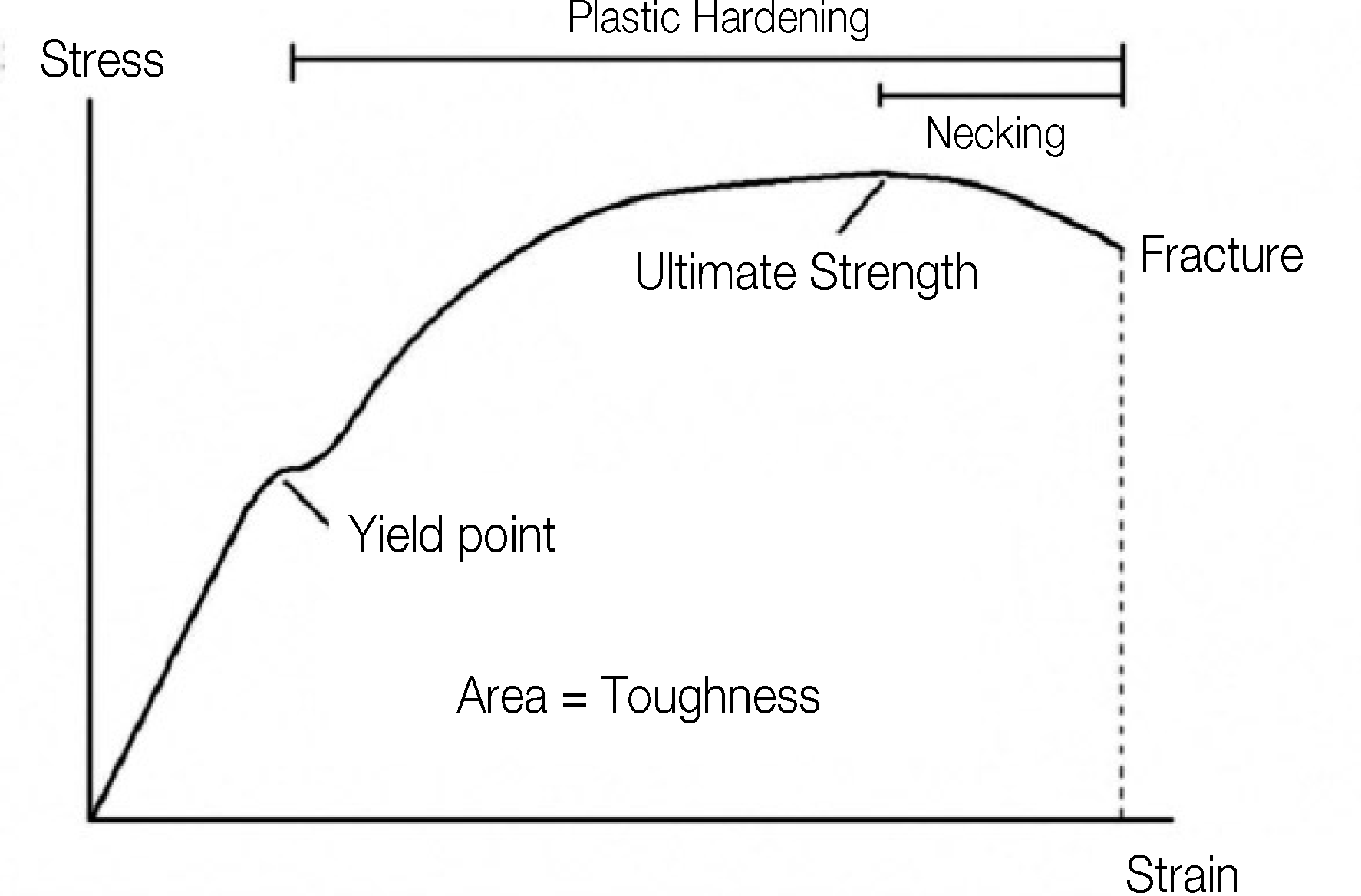 | Figure 4.Schematic diagram showing a typical stress (torsional load) versus strain (distortion angle) relationship, with the various stages of deformation labeled. The calculated area under the stress-strain curve up to the point of fracture represents the toughness of the specimen.46,50
|
 | Figure 5.Various machined surface of NiTi rotary files before cyclic loading (left) and micro-cracks near the fatigue fracture area. Fine cracks that assumed an irregular path were noted in TF and RaCe, whereas ProTaper and Helix showed cracks running along the machining grooves. This figure is reproduced from the Jounal of Endodontics 2010;36:147-152.44
|
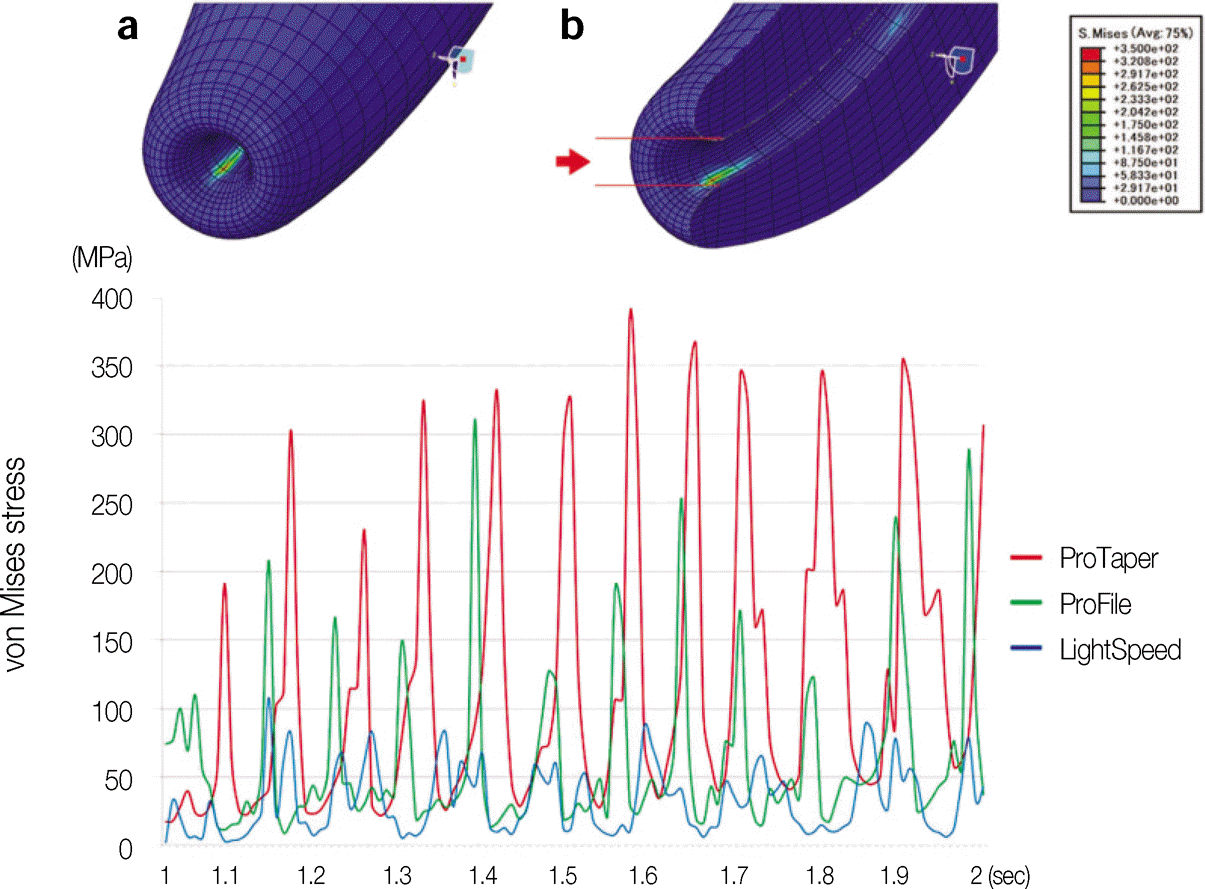 | Figure 6.Representative von Mises stress distribution at the apical dentin during simulated shaping rotation with ProTaper at the working length: (a) the apical aspect and (b) the longitudinal section. Arrow indicates the apical constriction where maximum stress was located. The graph shows the cyclic stress profile during simulated shaping over a period of 1 second for all three rotary instruments in the location (a node of FE model) in which the highest von Mises stress was found (highest stress value for each file: ProTaper 386 MPa, ProFile 311 MPa, LightSpeed 108 MPa). This figure is cited from the Journal of Endodontics 2010;36:1195-1199.60
|




 PDF
PDF ePub
ePub Citation
Citation Print
Print


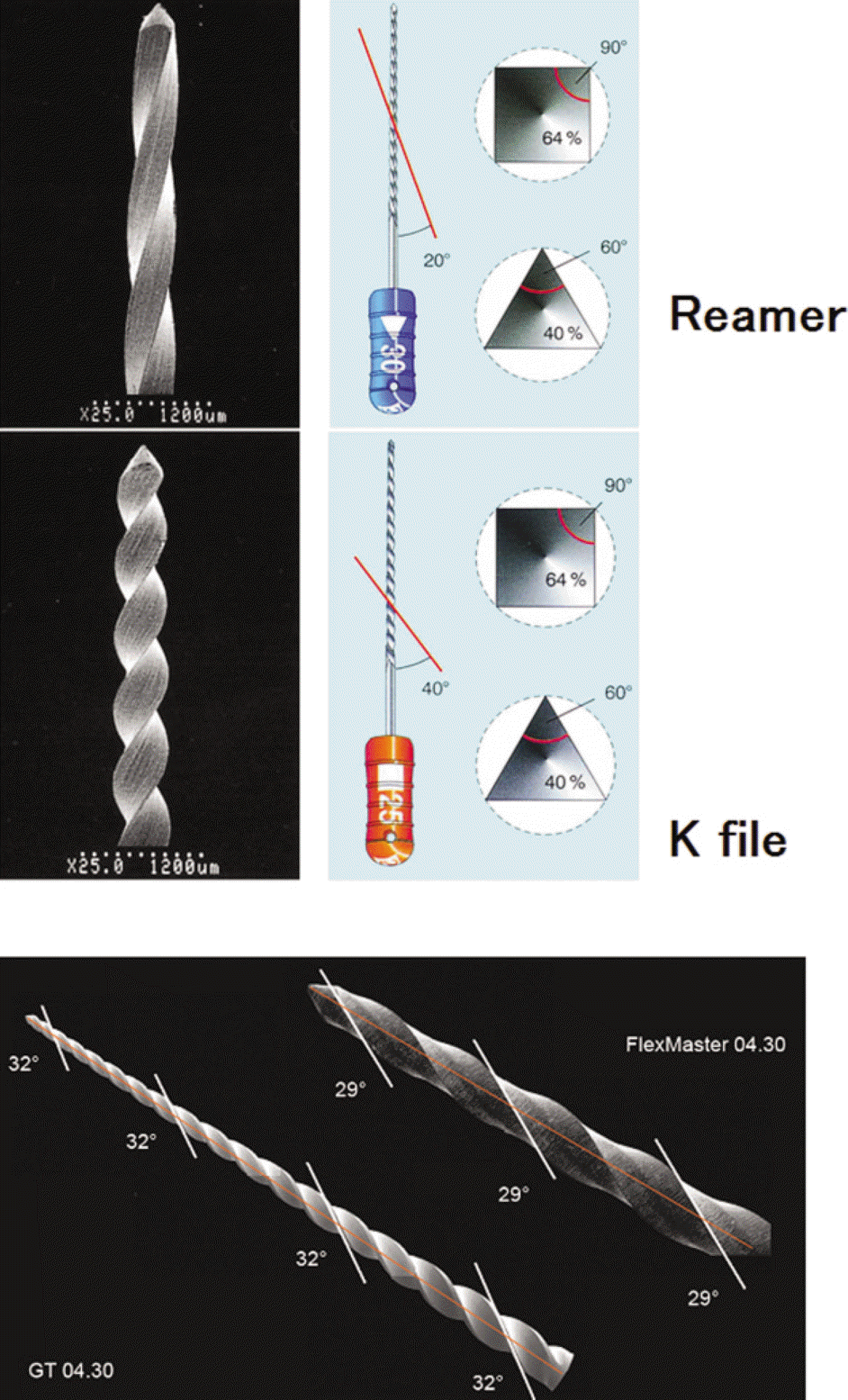
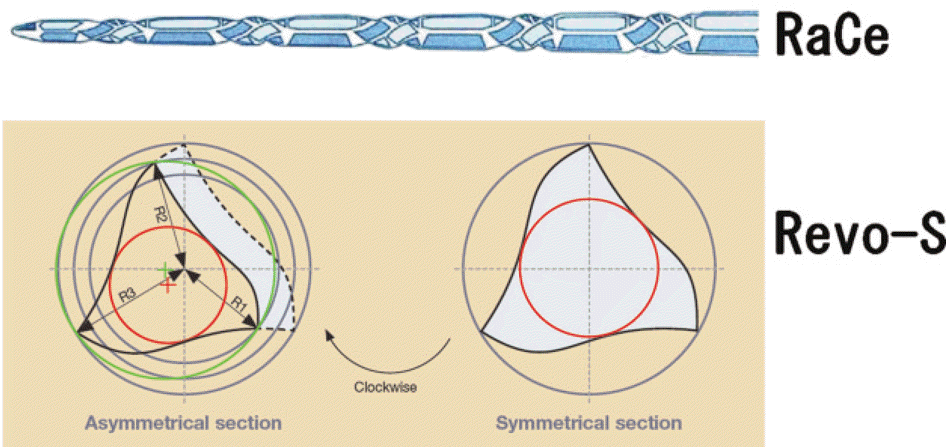
 XML Download
XML Download